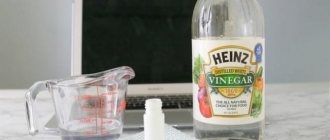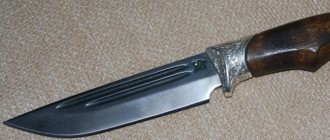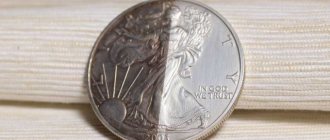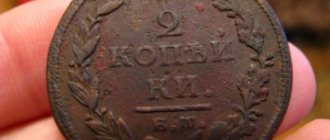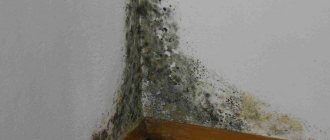Hard-to-remove red marks left by rust not only spoil the appearance of the surface, but also damage the material. To avoid corrosion, it is necessary to promptly remove the deposits that have formed.
But, do not rush to contact cleaning companies to remove such stains. Try it yourself using anti-rust vinegar. It will help get rid of most rust stains as quickly and easily as possible.
Why is vinegar effective against rust?
Under the influence of air and moisture, a red or red-brown coating of iron oxide forms on metal parts. It quickly spreads to adjacent surfaces.
For example, on the material around rusty buttons.
When exposed to acetic acid, iron oxide breaks down to form iron acetate and water, which are easily removed by washing or cleaning.
Acetic acid is an effective and fairly safe means of combating traces of rust on metal, glass, and tile surfaces. It has proven itself well in cleaning clothes, shoes, furniture and other household items.
This is interesting! How to clean gold with vinegar until it shines at home
Folk remedies
Not all gardeners and gardeners, when faced with rust on their property, use chemicals to combat it. If possible, they try to replace them with less harmful folk remedies. This fungal disease can be combated with the following most effective folk remedies:
- Add one crushed aspirin tablet, 1 tsp to four liters of water. dishwashing detergent and 1 tbsp. l. vegetable oil and soda. The bushes are sprayed with this product regularly once every 7 days.
- Fill the bucket a third with fresh manure and add water to the brim. The infusion will be ready after three days, during which it must be systematically stirred. The product filtered through a cloth is diluted with water in a ratio of 1:10 before use. Treat the bushes with a fresh solution only in the evening, when the sun has set, otherwise burns will appear on the foliage.
- The bucket is half filled with finely chopped weeds, and then it is filled to the brim with hot water. The infusion needs to be stirred periodically; it will be ready after a few days. The product, filtered through cheesecloth, is sprayed on the foliage of the bushes in the evening.
How to remove rust from clothes with vinegar
It is easiest to get rid of rust on fabric if the stains are fresh. They must be removed before sending the item for washing so that there are no unsightly stains of the cleaning solution left on the fabric. Before removing the stain, it is better to first clean the dust from your clothes with a brush.
Important! When working with acetic acid, protect your hands with gloves, especially if you have sensitive skin!
Removing rust from colored fabrics
Vinegar is often used when dyeing fabrics to set the color. Therefore, using it to wash colored clothes, you do not risk ruining their appearance. Actions step by step:
- Add a glass of table vinegar 9% to a basin with 5-6 liters of warm water.
- Place clothing in the solution and leave for 12 hours.
- Remove, wring out and wash in the washing machine on a standard program.
Getting rid of rust on white clothes
Vinegar is also suitable for cleaning white fabrics. First you need to study its composition and make sure that washing at high temperatures is allowed.
Actions step by step:
- Pour half a glass of 9% vinegar into a saucepan with three liters of water.
- Then heat the solution on the stove until intense steam appears.
- Pour water into a basin and soak the soiled clothes.
- Keep the item in the basin until the liquid cools completely.
- Wash your clothes with laundry detergent.
Coca Cola
There are a lot of ways to remove rust using Coca Cola on the Internet, let’s check it out. We took the most ordinary bottle, which is sold in any supermarket.
For example, in this video, we can see how Coca Cola perfectly removes rust from an old car bumper.
We'll just soak a cloth in Coca-Cola and leave it for a while. In our case, unfortunately, Coca-Cola did not help significantly remove the rust, despite the fact that the overall yellowness of the area decreased, the areas of corrosion did not change at all. The area after treatment with Coca-Cola looks just as terrible as before.
Nevertheless, Coca Cola can be used to clean surface rust well, since it contains phosphoric acid. But it’s better to use a rust converter directly with this acid.
The ideal way to remove rust with Coca-Cola is to put the rusty items in it and leave it for at least 24 hours. Look how we used this method to remove rust from old wheel bolts.
The components of the “classic” version of Coca-Cola are:
purified carbonated water; sugar; natural caramel coloring; acidity regulator orthophosphoric acid; natural flavors; caffeine.
Vinegar against rust stains on plumbing fixtures
Feel free to use acetic acid to clean your toilet or bathroom. Vinegar can remove rust from ceramic, acrylic surfaces, tiles and iron products.
How to remove rust from small metal objects
To remove rust from small objects, soak them entirely in table vinegar for 2-4 hours.
Note! The duration of the immersion depends on the degree of contamination. The larger and older the rusty coating, the longer the product needs to be kept in the vinegar solution.
Remove items, rinse with running water and wipe dry with a cloth.
If it is not possible to completely immerse the item in the solution, cover or wrap it in a cloth soaked in 9% table vinegar. Using a spray bottle, you can additionally moisten the fabric with acetic acid on top. After half an hour, thoroughly wipe the rust-damaged area with a soft sponge or a brush with gentle bristles. Repeat the procedure several times if necessary.
Advice! Rust stains can be cleaned off with food foil. To do this, aluminum foil is moistened in a vinegar solution and used as a scraper. Thus, chemical removal of rusty plaque occurs simultaneously with mechanical removal.
How to clean rust stains from a sink
In the bathroom, humidity is constantly increased, so over time, rust stains appear on the washbasin, bathtub, toilet and their metal parts.
Method 1: To remove a rusty stain from a sink or bathtub, soak a sponge or cloth in acetic acid. Apply it to the rusty area and leave it there for an hour. Then use the same cloth to rub the surface to be treated.
Method 2: To clean the toilet from rusty deposits, heat a glass of acetic acid to about 40 degrees. Pour hot vinegar over the inside of the toilet, thoroughly wetting the damaged areas. Rub it a little with a brush and leave the toilet in this state for 2-3 hours, then rinse with water.
Advice! To clean your plumbing, you can mix vinegar with...Coca-Cola! The drink contains orthophoric acid, which is good for coping with rusty plaque.
Materials
- Powdered citric acid - sold at a grocery store or pharmacy if you don't have it at home.
- A container where we will place steel objects for restoration.
- A scraper, like a spatula. Or a metal brush.
For security:
- Latex gloves.
- Protective glasses.
Benefits of using citric acid:
- Does not remove paint on surfaces.
- The reaction is completely controlled.
- Very affordable - almost always available in the kitchen.
- After use, you can pour it into the sink.
- Much cheaper than sandpaper and surface restorer.
Actually, the drive was just a breakthrough in electrolysis and galvanization. Everyone suddenly remembered their old-fashioned methods and began to put them into practice. This topic attracted me some time ago, I was looking for a way to galvanize the body and frame so that it would last forever. Well, or preserve it so that it doesn’t rot further. This note is a collection of various methods found on the Internet. I have successfully used some, such as the “vinegar compress,” in practice. I will be happy to listen to your methods and methods, dear readers.
Vinegar compress.
If the nuts and bolts are indecently stuck and WD-40 cannot unscrew them, ordinary vinegar will help us. A solution of acetic acid is available in any grocery store, the price is not high, but the effect is noticeable. If vinegar drains from an intractable node, you can make a vinegar compress by wrapping the piece of iron with a rag or cotton wool soaked in vinegar.
Acid-free reagents for removing rust.
Zinc chloride solution
The first thing you need is a power supply. Cut off the plug at the end of the power supply wire. Divide the end of the wire into two parts and strip the ends of the insulation. Twist the copper strands and, if possible, connect them to metal clamps. For example, you can buy micro alligator clips. Put all this aside and take a plastic bowl. Fill it with water to the depth required to clean the item you have chosen and dissolve baking soda in it. You shouldn't use a lot of baking soda, just a couple of spoons or so per 400 ml. Plug the power supply into the mains, keeping the two clamps far apart. If they touch, a short circuit will occur and the power supply will fail. Dip the clamps into the solution and notice where gas and hissing occurs. You must connect this clip to the thing. Connect the other clamp to a metal object. Do not use copper or brass items for this as they do not work very well. You now have an electrolysis kit. Dip both clamps into the solution and your item should start to fizz and bubble. Depending on how large the layer of dirt and oxides is on your item, the cleaning process should last from half a minute to several minutes, hours, days... The item being cleaned should bubble vigorously. If the gas evolution is small, then this is also not bad, the process will just go slower. The rate of electrolysis can be increased by adding more soda to the solution or by bringing the clamps closer together without actually touching them. Remove the item from the solution and clean it with a brush or soap. If you've kept the item in the solution long enough, the dirt should start to fall off, but you may need to repeat the electrolysis process again. Very stubborn contaminants may not yield to electrolysis at all, in which case they must be removed mechanically. After a while, you will notice that the solution in the vessel will become dirty. This does not come primarily from the item being cleaned, but rather from the metal anode that dissolves into the solution. You should replace the solution as often as the anode as it wears out. Power supply
: computer power supply, battery, charger - DC source 5-30 V, 1-15 A. Electrolyte
: solution of soda ash in water, 2/3 tablespoon of soda per 0.5 liter of water.
The concentration can be changed at the discretion of the master. They also use ordinary table soda, caustic soda, and “Mole” pipe cleaner. Anode
: 1.graphite - rods from old batteries.
We attach a graphite rod to the crocodile on the positive wire, and on the negative wire - an object that we will clean. 2.metal. When using stainless steel, harmful fumes are released, it is not suitable for work at home, but is more preferable for large volumes of processed parts.
How to clean the inside of an iron from rust
Over time, a rusty coating appears near the holes on the soleplate of the iron. And inside the device, salt deposits form from tap water, which is poured into the device to create steam when ironing clothes. A vinegar solution will help get rid of both of these problems at once.
Actions step by step:
- In a container of suitable volume, mix a glass of water and half a glass of 9% vinegar.
- Pour the solution into the iron.
- Turn on the device, setting the regulator to maximum temperature.
- Activate the steam function. Press the steam release button until all the liquid has evaporated.
- Fill the iron with clean water and use the sprayer. If your model does not have this feature, use the steam release button again.
- Turn off the iron. Wipe the warm sole with a dry cloth.
Pros and cons of deletion
Using vinegar to combat rust stains, you can appreciate a number of positive aspects:
The versatility of the product (vinegar solution perfectly removes red stains from metal, plastic and ceramics).- Availability (low cost, vinegar solution is available in any kitchen).
- Efficiency (at a pH of 2.5 pH, the vinegar solution dissolves stubborn stains of rust, grease and lime in a matter of minutes).
The downside to using a vinegar solution to remove rust stains is that it has a pungent odor.
An open window in the room and a few drops of your favorite essential oil, previously added to the cleaning solution, will help solve the problem of unpleasant odor.
FAQ
Which acetic acid to use to remove rust?
It is recommended to use 9% table vinegar for cleaning. Concentrated 70% vinegar essence must be diluted with water in the ratio: 1 part acid to 7 parts water.
Choose white vinegar to treat stains. Apple or wine analogues may leave unwanted stains or streaks. This is especially true for white fabrics and surfaces.
How to remove plaque using folk remedies?
The effectiveness of the exposure method is increased by a combination of chemical treatment and mechanical action. Homemade recipes are based on the use of easily available products that may already be in the household. Their main advantage is low cost and availability.
As a rule, the choice in favor of folk recipes is made with minor corrosion. Most often it is not difficult to deal with it.
Coca-Cola
Using Coca-Cola in the household allows you to clean various surfaces.
One popular recipe is to use the drink to remove rust. In order for the orthophosphoric acid in the drink to take effect, you can use a rag soaked in Cola. A rag is soaked generously in the drink and applied to the surface that needs to be cleaned from corrosion.
This recipe is suitable when the rust has not penetrated deep into the metal, since the concentration of phosphoric acid in Coca-Cola is low. The exposure time should be at least several hours, preferably a day.
But if the metal is seriously damaged, this method is ineffective. At the end of exposure, the cola is washed off with water and the surface is wiped dry. When using Cola, it is enough to use only rubber gloves as a means of protection. Read more about using Coca-Cola against rust here.
Lemon
One of the easiest recipes to deal with rust is to use citric acid.
To do this, the acid powder is diluted so that a very concentrated solution is obtained, with all grains completely dissolved.
The product can be used in two ways:
- apply generously with a sponge to the affected areas of the metal;
- soak a rag in the solution and apply to the rusted areas.
The last of the presented options is more effective, but even this method will not eliminate serious corrosion.
The duration of action of the composition is at least an hour. After this, the metal should be cleaned with a stiff brush, and the residue should be washed off. Read more about the use of citric acid in the fight against rust here.
Vinegar
Vinegar also allows you to remove rust during mild corrosion processes. For exposure, undiluted vinegar is used.
If the rusted items are small in size, they can be placed in a container and simply poured. For large metal objects, ensure that the cleaned surface comes into contact with vinegar.
After exposure to acetic acid, the surface is refined by mechanical rubbing and washing off the remaining vinegar.
Before painting directly, the metal must be primed. You can learn more about using vinegar to combat metal corrosion in this article.
Sorrel
Oxalic acid is a drug that comes in powder form. This remedy gives good results, but requires very careful use, as it is poisonous. Use may only be carried out in compliance with all necessary protective measures.
Before using acid, the metal surface should be prepared - washed with soap and dried. The treatment solution is prepared by diluting 6 tsp. acid in 300 ml. water.
How to use:
- Apply the solution generously with a brush.
- Leave for 30-40 minutes.
- Remove loose rust.
- Rinse off any remaining product with water.
Oxalic acid is suitable for advanced cases and large area surface treatment.
Orthophosphoric
Phosphoric acid is a commonly used component of ready-made rust converters.
This substance is highly effective and can be used even in advanced cases.
To prepare metal for painting, an acid concentration of 15-20% is required. Exposure to orthophosphoric acid should not be long - just 5 minutes is enough. After this, you can walk over the surface with a brush.
All work must be carried out in conditions of sufficient ventilation and using protective equipment. Read more about the use of phosphoric acid here.
The best iron converters in the form of a solution in jars
Permatex 81773
Automotive modifier for one-stage processing, which quickly copes with rust. A few minutes are enough to form a dense, chemically neutral black polymer coating on the metal, after which paint can be applied. This is an excellent primer that guarantees protection against the re-formation of a layer of rust. The composition is packaged in 454 g cans. This is enough to produce a large volume of work.
The anti-rust formula is designed so that it can be used in conjunction with putty and fiberglass. To apply the modifier evenly to the surface, use a brush. Operating temperature range: 10-32 degrees. The composition is used to remove oxide layers from agricultural machinery, cars and other types of machinery and equipment.
Advantages:
- performance. The corrosive layer is transformed in a matter of minutes;
- Possibility of use as a primer;
- 1-step processing.
Negative reviews relate to the limited area of application of the product. Thus, it cannot be used to process external metal parts of the machine.
Phenom
Fenom products are packaged in 110 ml jars. Despite the low price, it becomes clear that one bottle is not enough to treat a large area. Therefore, the use of the product is not cheap. You can use the modifier both during the primary processing of pure metal and as a means to combat rust. When using Fenom, the adhesion of paint and primer to the surface is improved, and anti-corrosion protection is provided for up to 7 years. When compared with similar compositions, Fenom is the undisputed champion in terms of speed of cleaning surfaces from rust deposits. The reddish coating is transformed into a durable layer of dark-colored soil.
Advantages:
- no rinsing required;
- speed of action;
- protective ferromanganese film on the surface;
- long-term rust protection.
Minuses:
- wasteful spending. To treat a large surface you will need several jars;
- overcharge.
ASTROhim
An effective rust converter from a domestic manufacturer. Available in aerosol form and in cans. The last option, according to many users, is more profitable. First of all, because a 0.5-liter jar of solution is not much more expensive than a 250-milligram bottle of aerosol. Secondly, the aerosol is not always on sale. The low price of ASTROhim does not mean that it is ineffective. It quite successfully competes with expensive products from other companies. The product is based on orthophosphoric acid, which destroys the oxide layer. The composition is applied with a brush, and then the layer affected by corrosion is removed using a special napkin. In this case, a film appears on the surface, ensuring good adhesion to coatings. Therefore, ASTROhim is also used as a prophylactic agent on clean metal before painting.
Advantages:
- good cleaning quality;
- low price.
Disadvantage: the need for washing in the most thorough manner.
YASKHIM
The Yashim rust converter is designed to prepare metal before painting. It is used as an alternative to phosphating or as a self-sufficient anti-corrosion agent. The composition forms a protective zinc phosphate coating on the surface. The chemical reaction with iron oxides is selective. Pure metal remains undamaged. The modifier reacts extremely quickly with oxides, which allows you to quickly remove or transform even thick layers of metallurgical scale or rust. The surface treated with YASKHIM does not need to be additionally degreased.
Advantages:
- low cost;
- efficiency.
There are no cons.
START
Liquid product from Russian manufacturers. The converter is packaged in 500 ml jars. After application, a protective phosphate film is formed on the metal. START is excellent for pre-treatment of metal surfaces before painting. The paint layer is smooth and durable.
Advantages:
- versatility (can be used for any metal);
- formation of a protective film of phosphates on the surface.
Disadvantage: the product cannot cope with a thick layer of rust.
Auto cleaner
A good rust remover is car metal cleaner. This product is available: it can be purchased at any store specialized in automotive products. Before application, it is recommended to clean the surface affected by rust with a stiff brush. After which the area is covered with a layer of product up to 5 millimeters thick and left for a couple of minutes. Then you need to wash off the residue and wipe the surface until dry. If the rust is not completely gone, repeat the procedure.
It should be remembered that any rust remover is toxic. These are usually acids that, if they come into contact with the skin, cause a burn. It is necessary to work in protective gloves, goggles and a respirator. Additionally, it would be a good idea to carefully read the instructions for use and precautions.
Baking soda
Method: Rinse the metal object and wipe dry. Sprinkle baking soda (it will stick to wet areas), making sure to cover any rusty areas. Leave the item for an hour or so, then scrub with steel wool or a wire brush, removing the rust down to the metal. When cleaning the pan, use a dish sponge. Rinse and dry with a towel.
The method is effective for minor rust on baking sheets, thin metal, etc.
Pros: Simple method using one cheap, common product.
Cons: It takes at least an hour before you can actually start removing the rust.
Prevention of corrosion
To prevent corrosion from damaging the metal, it is necessary to pay attention to preventive measures.
Surfaces without an external coating are most susceptible to corrosion . In humid conditions and with access to oxygen, such metal rusts very quickly.
The solution to the problem is timely care of metal elements, which would prevent the growth of corrosion processes. After removing the rust, it is advisable to protect the surface from moisture with a coating.

